Validation and Comparison of MODIS C6.1 and C6 Aerosol Products over Beijing, China
Abstract
1. Introduction
2. Field Measurements and Data Used
2.1. AERONET
2.2. MODIS Aerosol Retrieval Algorithms and Products over Land
2.3. Spatial and Temporal Matching
3. Assessment of MODIS AOD Products over the Beijing Region
3.1. Comparison of the C6.1 DT and DB AOD Products
3.2. Comparison of the C6 and C6.1 Aerosol Products
3.3. Validation of the C6 and C6.1 DT AOD Products
3.4. Validation of the C6 and C6.1 DB AOD Products
4. Discussion
4.1. Influence of Surface Reflectance Estimation
4.2. Influence of Aerosol Type Parameterization
5. Conclusions
Author Contributions
Funding
Acknowledgments
Conflicts of Interest
References
- Sun, J.M.; Ariya, P.A. Atmospheric organic and bio-aerosols as cloud condensation nuclei (CCN): A review. Atmos. Environ. 2006, 40, 795–820. [Google Scholar] [CrossRef]
- Butt, E.W.; Rap, A.; Schmidt, A.; Scott, C.E.; Pringle, K.J.; Reddington, C.L.; Richards, N.A.D.; Woodhouse, M.T.; Ramirez-Villegas, J.; Yang, H.; et al. The impact of residential combustion emissions on atmospheric aerosol, human health, and climate. Atmos. Chem. Phys. 2016, 16, 873–905. [Google Scholar] [CrossRef]
- Pope, C.A.; Dockery, D.W. Health effects of fine particulate air pollution: Lines that connect. J. Air Waste Manag. Assoc. 2006, 56, 709–742. [Google Scholar] [CrossRef] [PubMed]
- Kaufman, Y.J.; Tanre, D.; Boucher, O. A satellite view of aerosols in the climate system. Nature 2002, 419, 215–223. [Google Scholar] [CrossRef] [PubMed]
- Chen, W.; Fan, A.P.; Yan, L. Performance of MODIS C6 aerosol product during frequent haze-fog events: A case study of Beijing. Remote Sens. 2017, 9, 496. [Google Scholar] [CrossRef]
- Misra, A.; Jayaraman, A.; Ganguly, D. Validation of MODIS derived aerosol optical depth over Western India. J. Geophys. Res. Atmos. 2008, 113. [Google Scholar] [CrossRef]
- Bilal, M.; Nichol, J.E.; Chan, P.W. Validation and accuracy assessment of a simplified aerosol retrieval algorithm (SARA) over beijing under low and high aerosol loadings and dust storms. Remote Sens. Environ. 2014, 153, 50–60. [Google Scholar] [CrossRef]
- Gupta, P.; Levy, R.C.; Mattoo, S.; Remer, L.A.; Munchak, L.A. A surface reflectance scheme for retrieving aerosol optical depth over urban surfaces in MODIS dark target retrieval algorithm. Atmos. Meas. Tech. 2016, 9, 3293–3308. [Google Scholar] [CrossRef]
- Sogacheva, L.; de Leeuw, G.; Rodriguez, E.; Kolmonen, P.; Georgoulias, A.K.; Alexandri, G.; Kourtidis, K.; Proestakis, E.; Marinou, E.; Amiridis, V.; et al. Spatial and seasonal variations of aerosols over China from two decades of multi-satellite observations—Part 1: Atsr (1995-2011) and MODIS C6.1 (2000–2017). Atmos. Chem. Phys. 2018, 18, 11389–11407. [Google Scholar] [CrossRef]
- Bilal, M.; Nazeer, M.; Qiu, Z.; Ding, X.; Wei, J. Global validation of MODIS C6 and C6.1 merged aerosol products over diverse vegetated surfaces. Remote Sens. 2018, 10, 475. [Google Scholar] [CrossRef]
- Zhang, Q.; Ma, X.C.; Tie, X.X.; Huang, M.Y.; Zhao, C.S. Vertical distributions of aerosols under different weather conditions: Analysis of in-situ aircraft measurements in Beijing, China. Atmos. Environ. 2009, 43, 5526–5535. [Google Scholar] [CrossRef]
- Holben, B.N.; Eck, T.F.; Slutsker, I.; Tanre, D.; Buis, J.P.; Setzer, A.; Vermote, E.; Reagan, J.A.; Kaufman, Y.J.; Nakajima, T.; et al. AERONET—A federated instrument network and data archive for aerosol characterization. Remote Sens. Environ. 1998, 66, 1–16. [Google Scholar] [CrossRef]
- Smirnov, A.; Holben, B.N.; Eck, T.F.; Dubovik, O.; Slutsker, I. Cloud-screening and quality control algorithms for the AERONET database. Remote Sens. Environ. 2000, 73, 337–349. [Google Scholar] [CrossRef]
- He, Q.Q.; Zhang, M.; Huang, B.; Tong, X.L. MODIS 3 km and 10 km aerosol optical depth for China: Evaluation and comparison. Atmos. Environ. 2017, 153, 150–162. [Google Scholar] [CrossRef]
- Wei, J.; Sun, L.; Huang, B.; Bilal, M.; Zhang, Z.; Wang, L. Verification, improvement and application of aerosol optical depths in China part 1: Inter-comparison of NPP-VIIRS and aqua-MODIS. Atmos. Environ. 2018, 175, 221–233. [Google Scholar] [CrossRef]
- Sayer, A.M.; Munchak, L.A.; Hsu, N.C.; Levy, R.C.; Bettenhausen, C.; Jeong, M.J. MODIS collection 6 aerosol products: Comparison between aqua’s e-deep blue, dark target, and “merged” data sets, and usage recommendations. J. Geophys. Res. Atmos. 2014, 119, 13965–13989. [Google Scholar] [CrossRef]
- Chu, D.A.; Kaufman, Y.J.; Ichoku, C.; Remer, L.A.; Tanre, D.; Holben, B.N. Validation of MODIS aerosol optical depth retrieval over land. Geophys. Res. Lett. 2002, 29, MOD2-1. [Google Scholar] [CrossRef]
- Lee, J.; Kim, J.; Song, C.H.; Kim, S.B.; Chun, Y.; Sohn, B.J.; Holben, B.N. Characteristics of aerosol types from AERONET sunphotometer measurements. Atmos. Environ. 2010, 44, 3110–3117. [Google Scholar] [CrossRef]
- Levy, R.C.; Mattoo, S.; Munchak, L.A.; Remer, L.A.; Sayer, A.M.; Patadia, F.; Hsu, N.C. The collection 6 MODIS aerosol products over land and ocean. Atmos. Meas. Tech. 2013, 6, 2989–3034. [Google Scholar] [CrossRef]
- Hsu, N.C.; Jeong, M.J.; Bettenhausen, C.; Sayer, A.M.; Hansell, R.; Seftor, C.S.; Huang, J.; Tsay, S.C. Enhanced deep blue aerosol retrieval algorithm: The second generation. J. Geophys. Res. Atmos. 2013, 118, 9296–9315. [Google Scholar] [CrossRef]
- Sayer, A.M.; Hsu, N.C.; Bettenhausen, C.; Jeong, M.J. Validation and uncertainty estimates for MODIS collection 6 “deep blue” aerosol data. J. Geophys. Res. Atmos. 2013, 118, 7864–7872. [Google Scholar] [CrossRef]
- Ichoku, C.; Chu, D.A.; Mattoo, S.; Kaufman, Y.J.; Remer, L.A.; Tanre, D.; Slutsker, I.; Holben, B.N. A spatio-temporal approach for global validation and analysis of MODIS aerosol products. Geophys. Res. Lett. 2002, 29. [Google Scholar] [CrossRef]
- Schaap, M.; Timmermans, R.M.A.; Koelemeijer, R.B.A.; de Leeuw, G.; Builtjes, P.J.H. Evaluation of MODIS aerosol optical thickness over europe using sun photometer observations. Atmos. Environ. 2008, 42, 2187–2197. [Google Scholar] [CrossRef]
- Tian, X.P.; Liu, S.H.; Sun, L.; Liu, Q. Retrieval of aerosol optical depth in the arid or semiarid region of northern Xinjiang, China. Remote Sens. 2018, 10, 197. [Google Scholar] [CrossRef]
- Xie, Y.; Zhang, Y.; Xiong, X.X.; Qu, J.J.; Che, H.Z. Validation of MODIS aerosol optical depth product over China using carsnet measurements. Atmos. Environ. 2011, 45, 5970–5978. [Google Scholar] [CrossRef]
- Tao, M.H.; Chen, L.F.; Wang, Z.F.; Tao, J.H.; Che, H.Z.; Wang, X.H.; Wang, Y. Comparison and evaluation of the MODIS collection 6 aerosol data in China. J. Geophys. Res. Atmos. 2015, 120, 6992–7005. [Google Scholar] [CrossRef]
- Georgoulias, A.K.; Alexandri, G.; Kourtidis, K.A.; Lelieveld, J.; Zanis, P.; Amiridis, V. Differences between the MODIS collection 6 and 5.1 aerosol datasets over the greater mediterranean region. Atmos. Environ. 2016, 147, 310–319. [Google Scholar] [CrossRef]
- Nichol, J.E.; Bilal, M. Validation of MODIS 3 km resolution aerosol optical depth retrievals over asia. Remote Sens. 2016, 8, 328. [Google Scholar] [CrossRef]
- Shen, X.J.; Bilal, M.; Qiu, Z.F.; Sun, D.Y.; Wang, S.Q.; Zhu, W.J. Validation of MODIS c6 dark target aerosol products at 3 km and 10 km spatial resolutions over the China Seas and the Eastern Indian Ocean. Remote Sens. 2018, 10, 573. [Google Scholar] [CrossRef]
- Feng, X.; Li, Q.; Zhu, Y.J.; Wang, J.J.; Liang, H.M.; Xu, R.F. Formation and dominant factors of haze pollution over beijing and its peripheral areas in winter. Atmos. Pollut. Res. 2014, 5, 528–538. [Google Scholar] [CrossRef]
- Chin, M.; Chu, A.; Levy, R.; Remer, L.; Kaufman, Y.; Holben, B.; Eck, T.; Ginoux, P.; Gao, Q.X. Aerosol distribution in the northern hemisphere during ACE-Asia: Results from global model, satellite observations, and sun photometer measurements. J. Geophys. Res. Atmos. 2004, 109. [Google Scholar] [CrossRef]
- Kaufman, Y.J.; Holben, B.N.; Tanre, D.; Slutsker, I.; Smirnov, A.; Eck, T.F. Will aerosol measurements from terra and aqua polar orbiting satellites represent the daily aerosol abundance and properties? Geophys. Res. Lett. 2000, 27, 3861–3864. [Google Scholar] [CrossRef]
- Huang, J.F.; Kondragunta, S.; Laszlo, I.; Liu, H.Q.; Remer, L.A.; Zhang, H.; Superczynski, S.; Ciren, P.; Holben, B.N.; Petrenko, M. Validation and expected error estimation of suomi-NPP VIIRS aerosol optical thickness and angstrom exponent with AERONET. J. Geophys. Res. Atmos. 2016, 121, 7139–7160. [Google Scholar] [CrossRef]
- Levy, R.C.; Remer, L.A.; Dubovik, O. Global aerosol optical properties and application to moderate resolution imaging spectroradiometer aerosol retrieval over land. J. Geophys. Res. Atmos. 2007, 112. [Google Scholar] [CrossRef]
- He, C.; Liou, K.N.; Takano, Y.; Zhang, R.; Zamora, M.L.; Yang, P.; Li, Q.; Leung, L.R. Variation of the radiative properties during black carbon aging: Theoretical and experimental intercomparison. Atmos. Chem. Phys. 2015, 15, 11967–11980. [Google Scholar] [CrossRef]
- China, S.; Scarnato, B.; Owen, R.C.; Zhang, B.; Ampadu, M.T.; Kumar, S.; Dzepina, K.; Dziobak, M.P.; Fialho, P.; Perlinger, J.A.; et al. Morphology and mixing state of aged soot particles at a remote marine free troposphere site: Implications for optical properties. Geophys. Res. Lett. 2015, 42, 1243–1250. [Google Scholar] [CrossRef]
- Wei, J.; Sun, L.; Peng, Y.; Wang, L.; Zhang, Z.; Bilal, M.; Ma, Y. An improved high-spatial-resolution aerosol retrieval algorithm for MODIS images over land. J. Geophys. Res. Atmos. 2018, 123, 12–291. [Google Scholar] [CrossRef]
- Tian, X.P.; Sun, L.; Liu, Q.; Li, X.H. Retrieval of high-resolution aerosol optical depth using landsat 8 oli data over beijing. J. Remote Sens. 2018, 22, 51–63. [Google Scholar]
- Zhu, J.; Xia, X.G.; Wang, J.; Che, H.Z.; Chen, H.B.; Zhang, J.Q.; Xu, X.G.; Levy, R.C.; Oo, M.; Holz, R.; et al. Evaluation of aerosol optical depth and aerosol models from VIIRS retrieval algorithms over North China Plain. Remote Sens. 2017, 9, 432. [Google Scholar] [CrossRef]
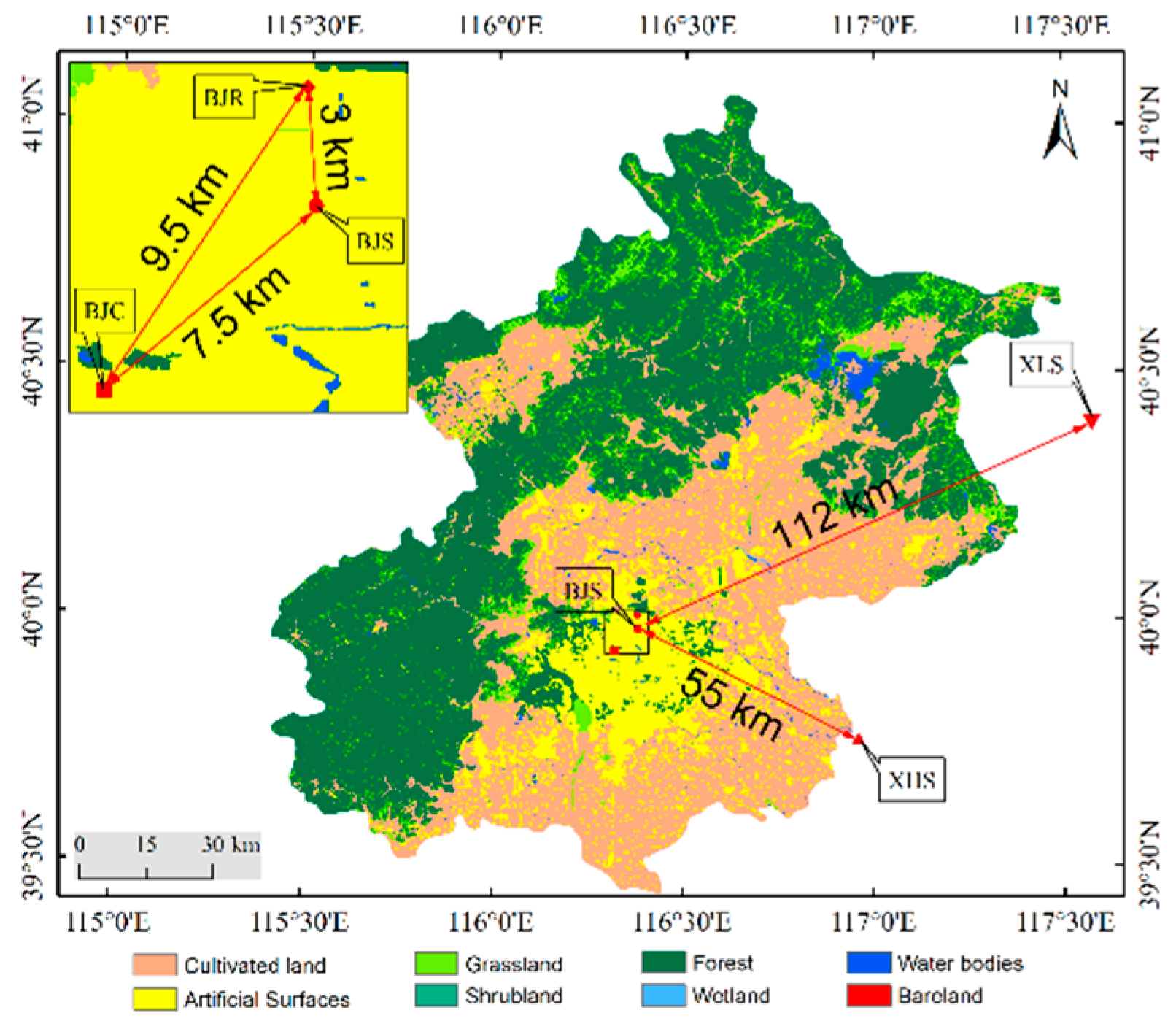
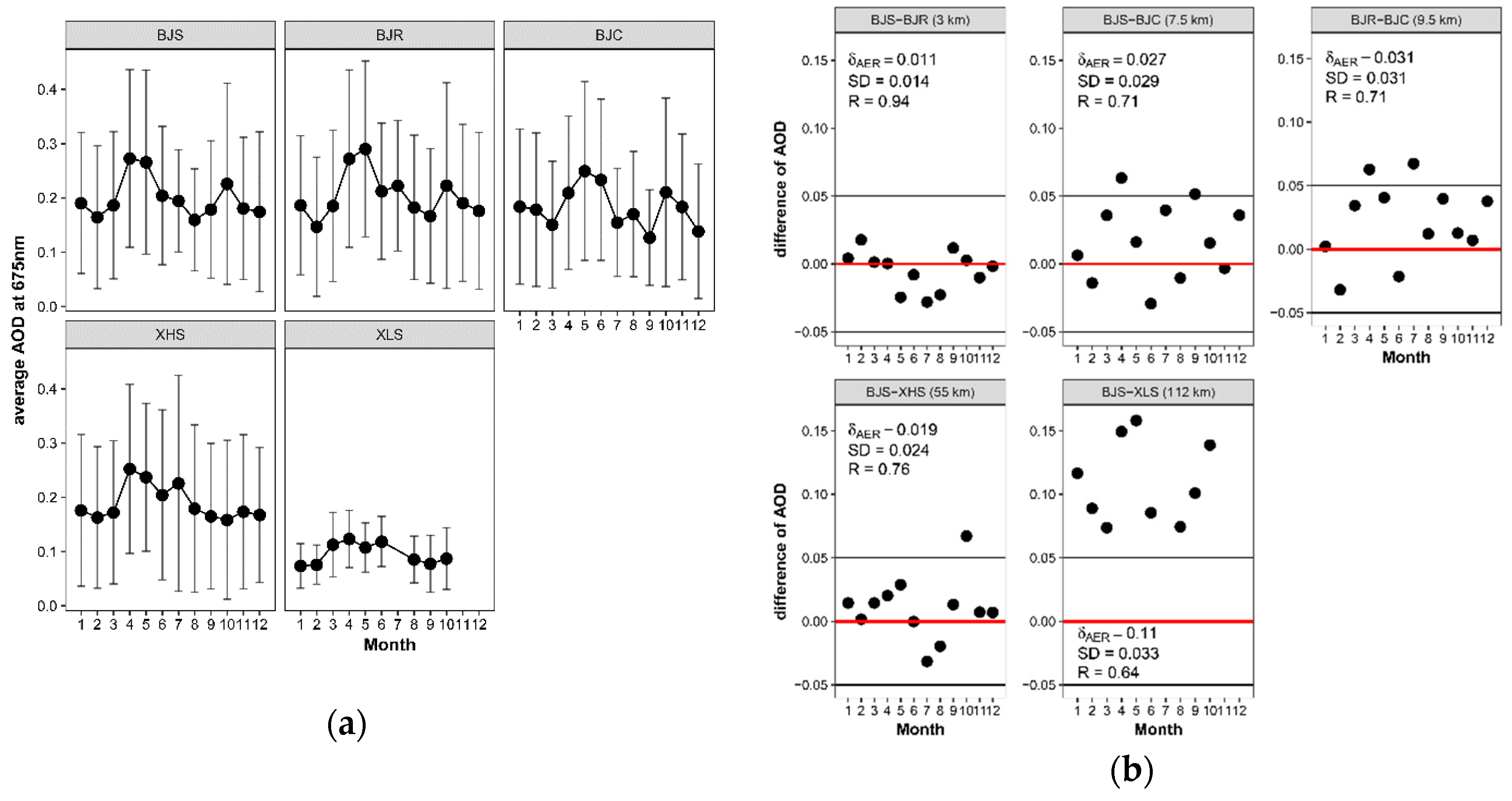
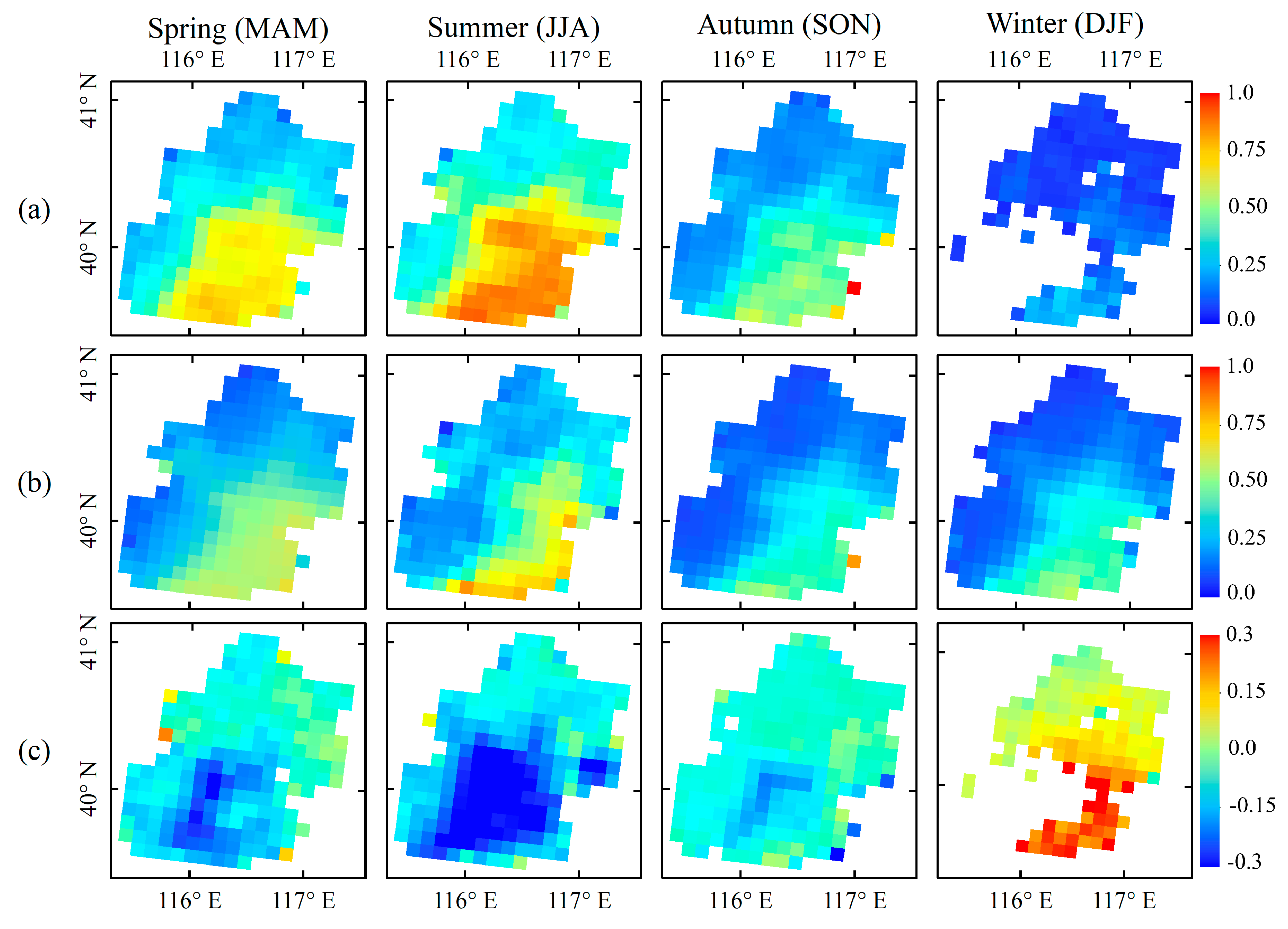
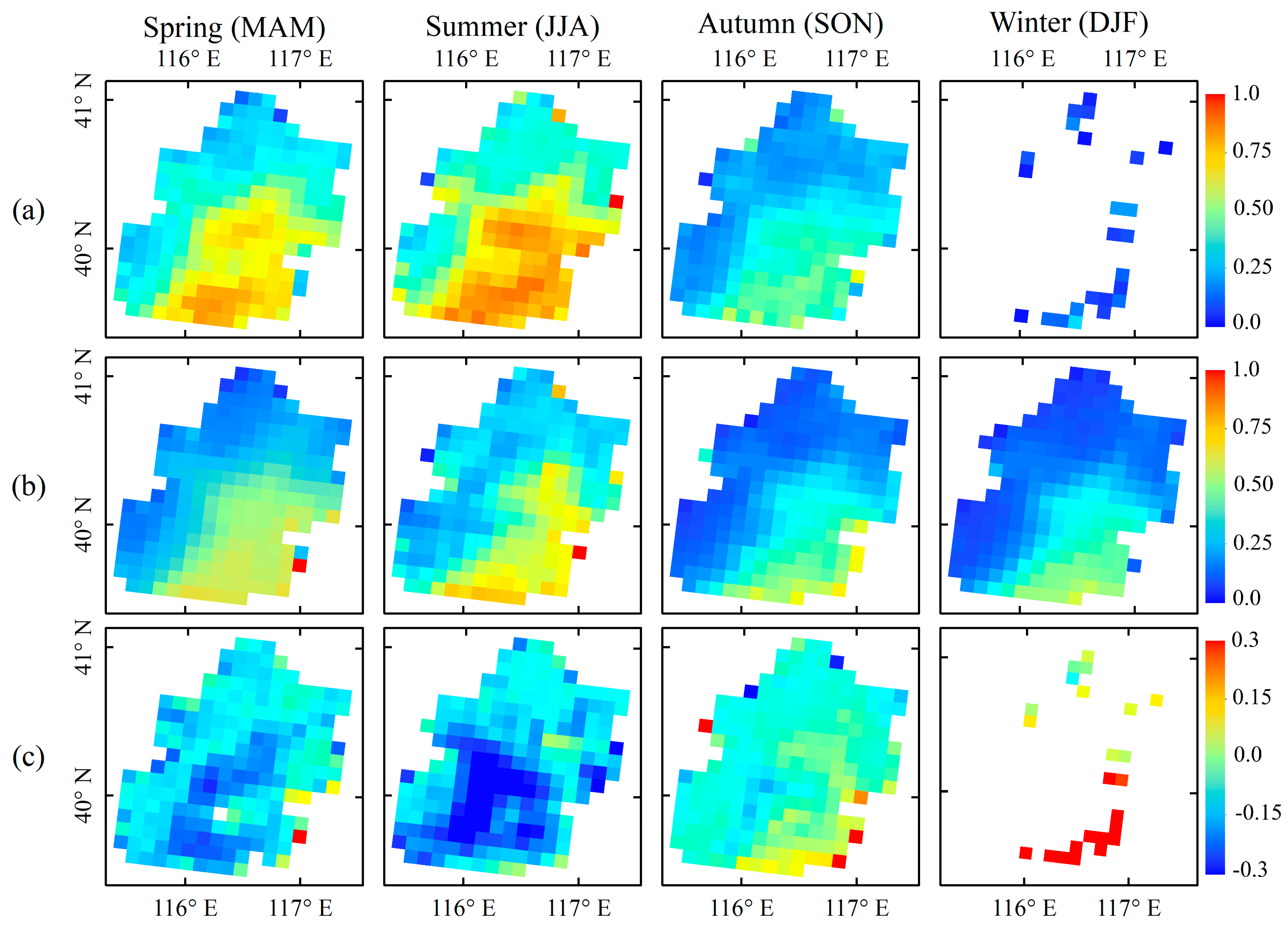
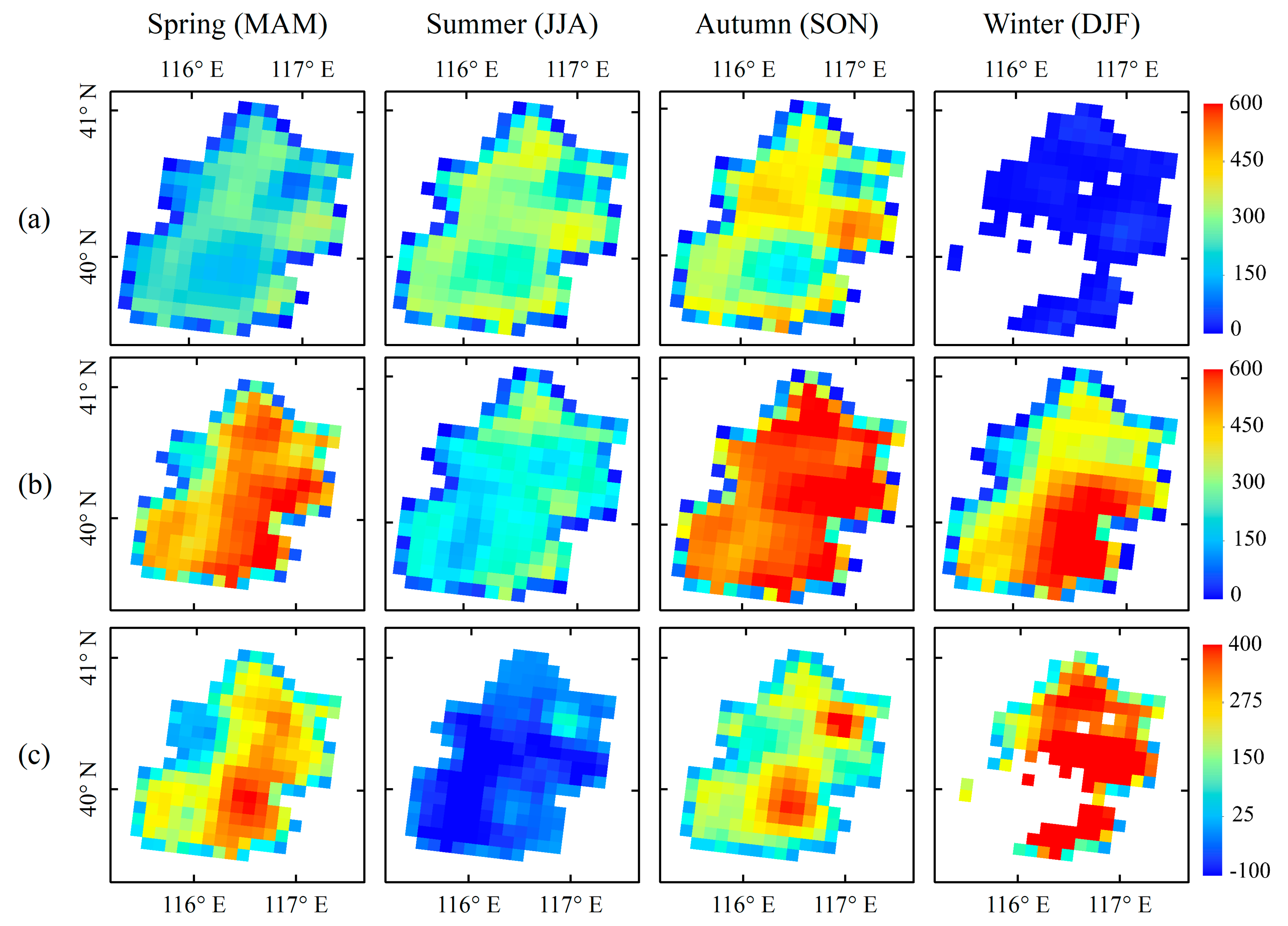
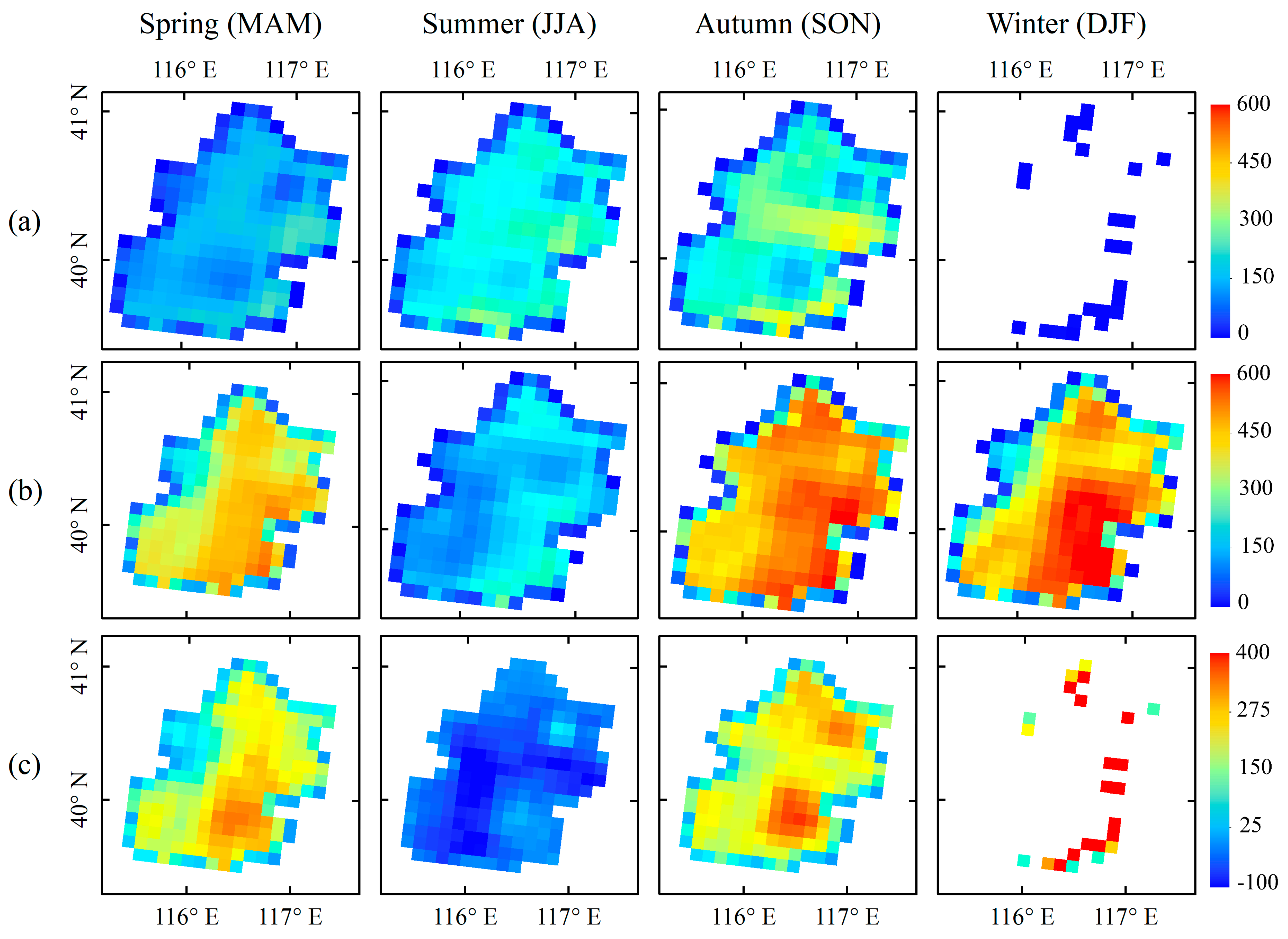
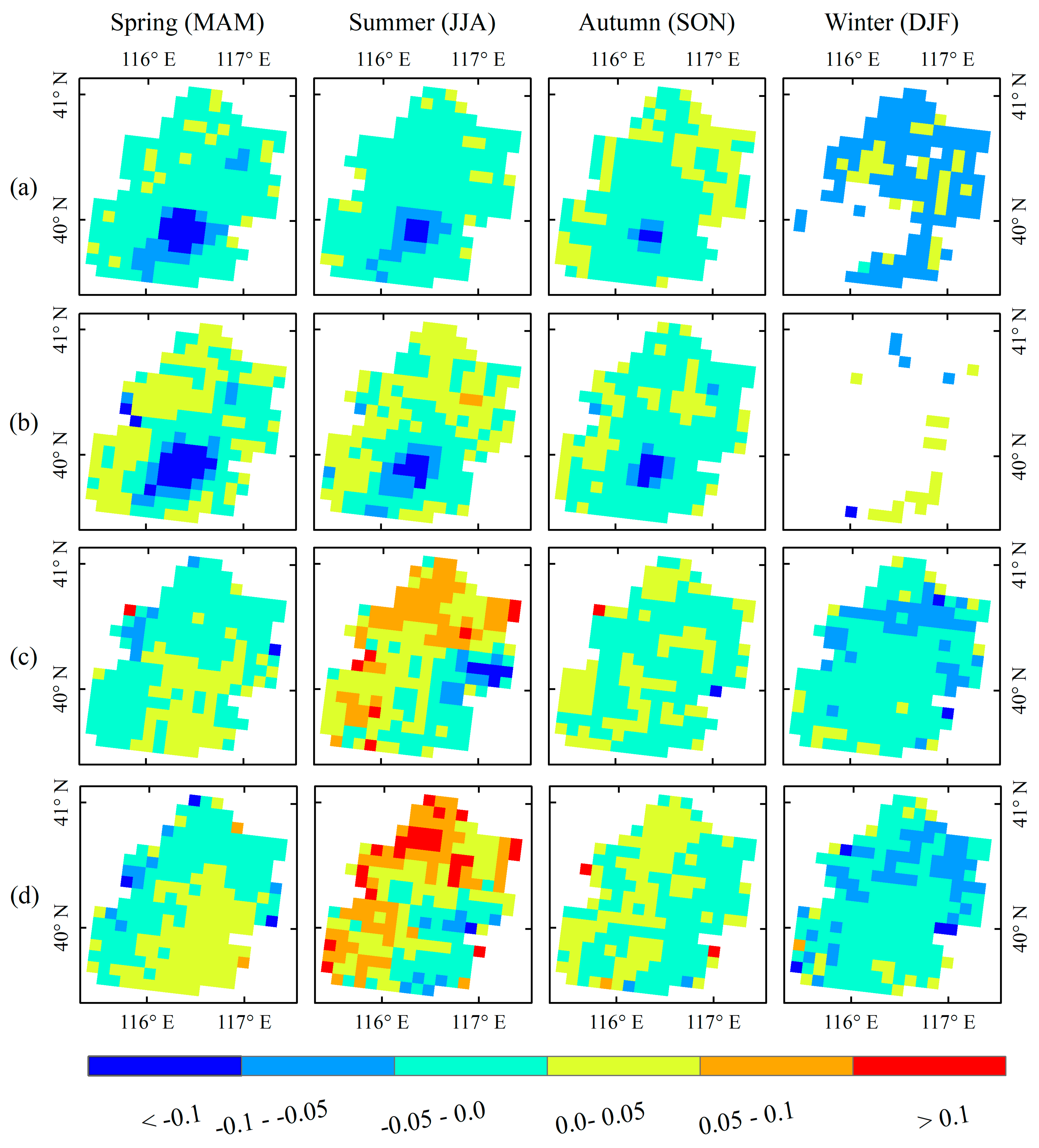
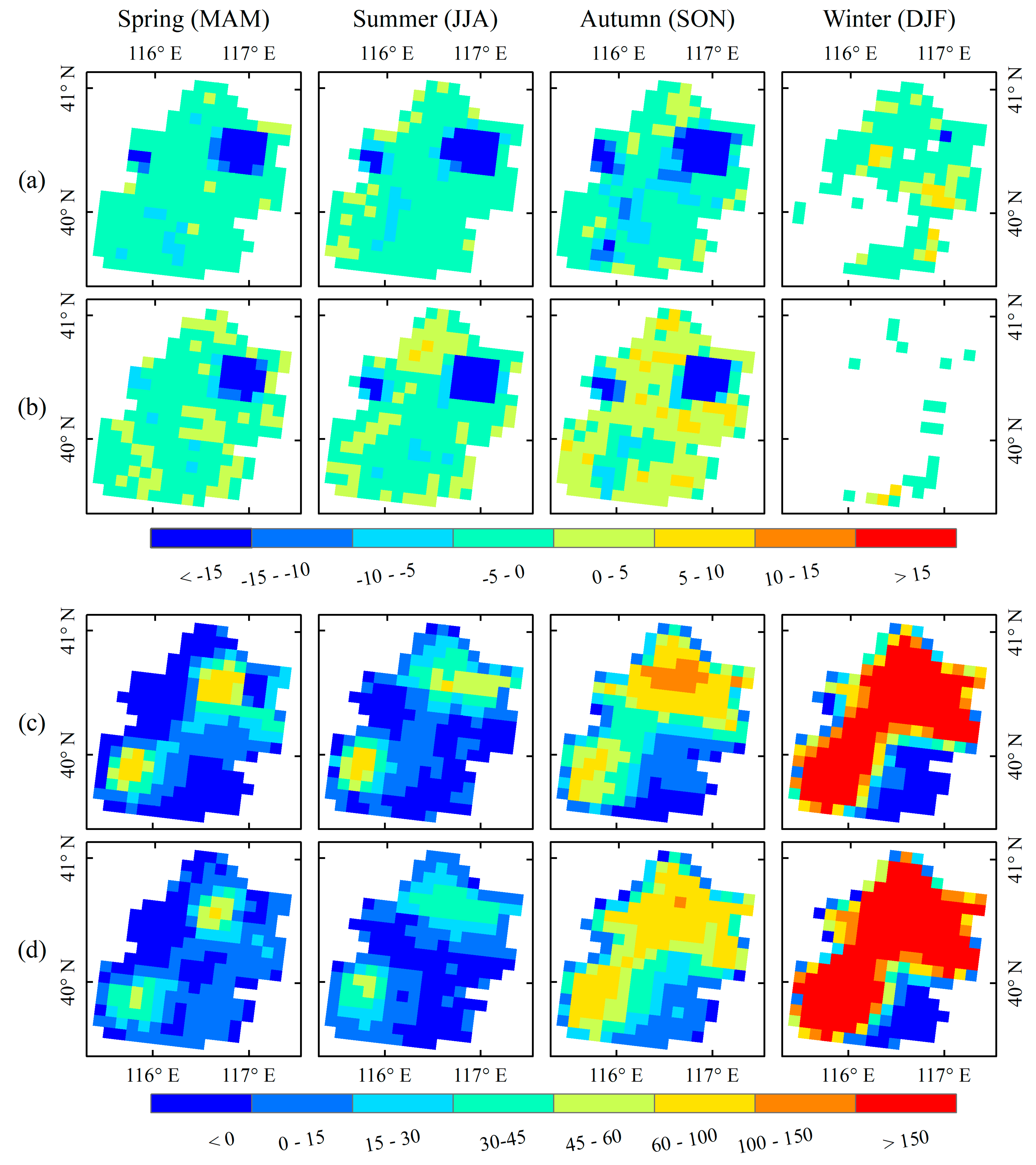
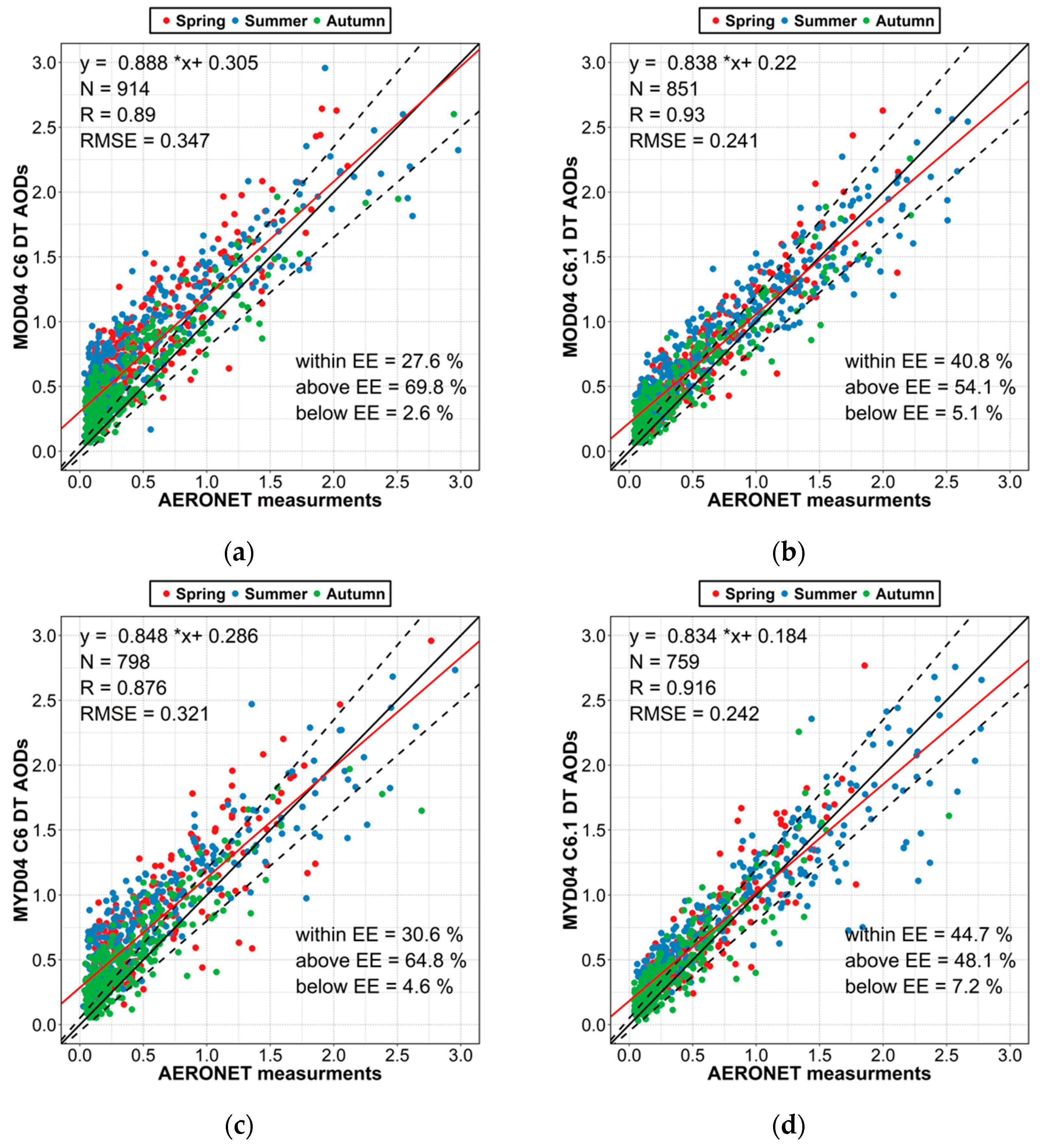
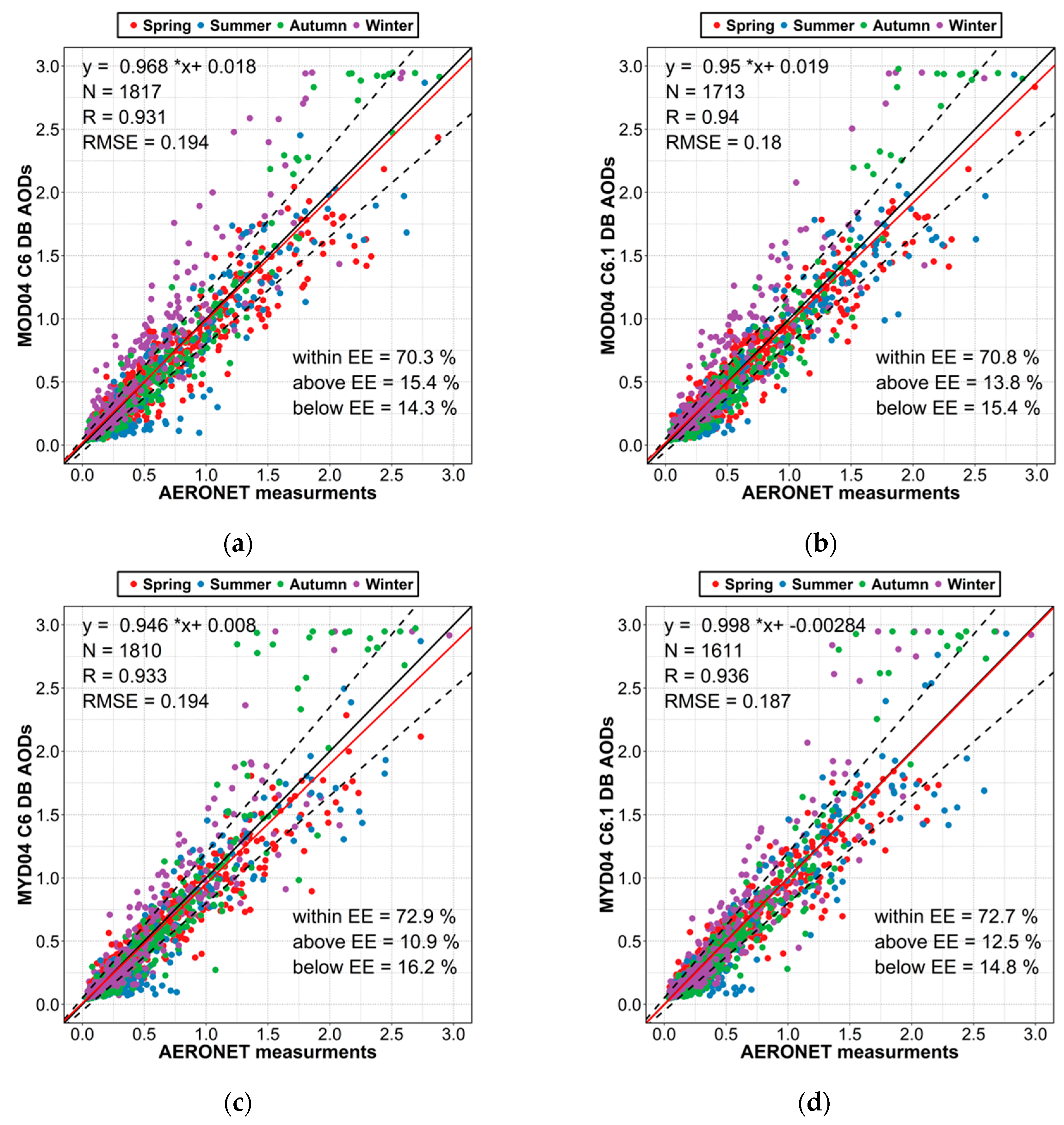
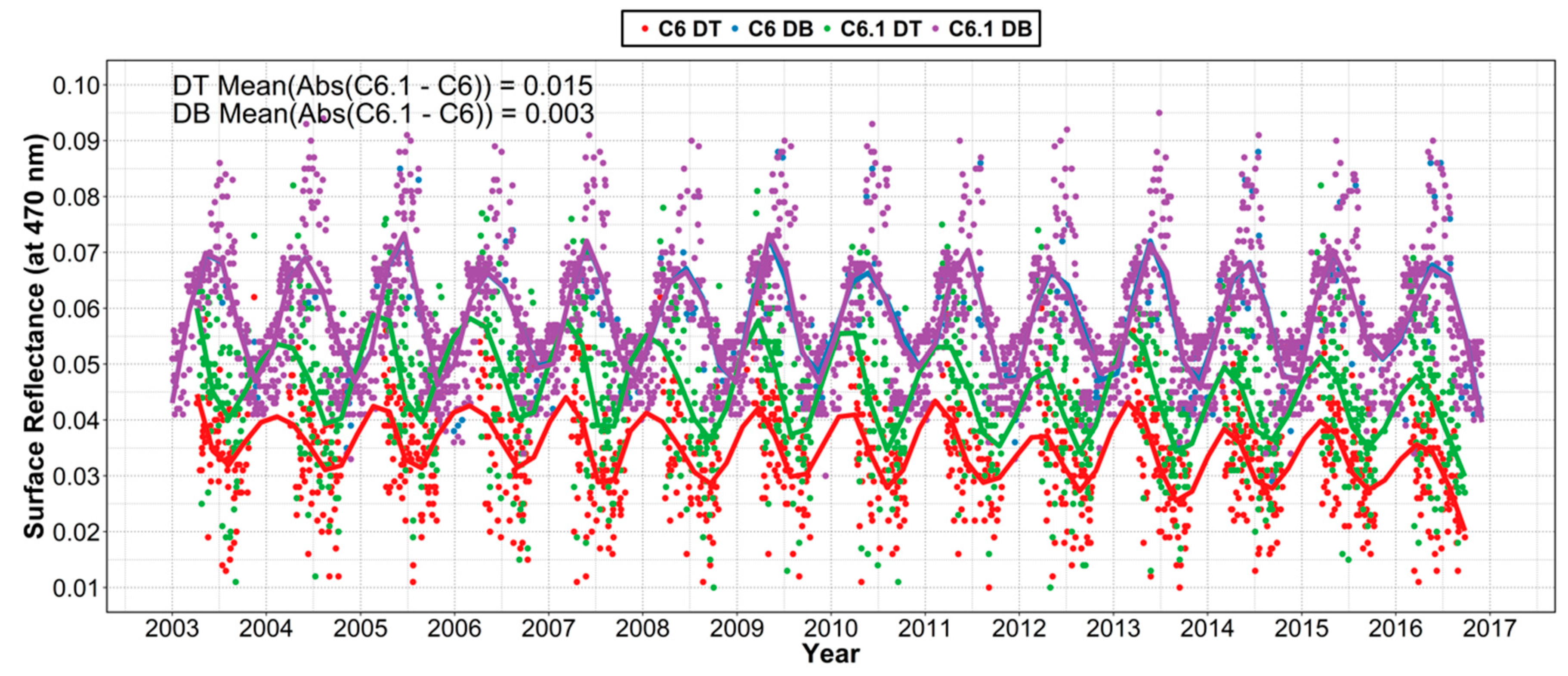
| Season | Sensor | N | PWE (%) | PAE (%) | PBE (%) | R | RMSE | ||||||
|---|---|---|---|---|---|---|---|---|---|---|---|---|---|
| C6 | C6.1 | C6 | C6.1 | C6 | C6.1 | C6 | C6.1 | C6 | C6.1 | C6 | C6.1 | ||
| Spring | Terra | 281 | 233 | 21.0 | 36.5 | 76.9 | 60.1 | 2.1 | 3.4 | 0.864 | 0.924 | 0.388 | 0.232 |
| Aqua | 208 | 184 | 25.0 | 42.4 | 70.7 | 52.7 | 4.3 | 4.9 | 0.841 | 0.895 | 0.373 | 0.229 | |
| Summer | Terra | 298 | 330 | 22.1 | 39.4 | 74.8 | 54.2 | 3.1 | 6.4 | 0.902 | 0.928 | 0.407 | 0.288 |
| Aqua | 282 | 296 | 24.8 | 38.9 | 72.3 | 52.0 | 2.9 | 9.1 | 0.900 | 0.917 | 0.369 | 0.299 | |
| Autumn | Terra | 335 | 288 | 37.9 | 45.8 | 59.4 | 49.0 | 2.7 | 5.2 | 0.907 | 0.930 | 0.232 | 0.182 |
| Aqua | 308 | 279 | 39.6 | 52.3 | 53.9 | 40.9 | 6.5 | 6.8 | 0.875 | 0.899 | 0.220 | 0.175 | |
| Winter | Terra | - | - | - | - | - | - | - | - | - | - | - | - |
| Aqua | - | - | - | - | - | - | - | - | - | - | - | - | |
| Season | Sensor | N | PWE (%) | PAE (%) | PBE (%) | R | RMSE | ||||||
|---|---|---|---|---|---|---|---|---|---|---|---|---|---|
| C6 | C6.1 | C6 | C6.1 | C6 | C6.1 | C6 | C6.1 | C6 | C6.1 | C6 | C6.1 | ||
| Spring | Terra | 550 | 532 | 70.7 | 70.1 | 10.2 | 10.2 | 19.1 | 19.7 | 0.952 | 0.955 | 0.174 | 0.167 |
| Aqua | 466 | 424 | 71.5 | 75.7 | 8.4 | 9.4 | 20.1 | 14.9 | 0.947 | 0.952 | 0.173 | 0.146 | |
| Summer | Terra | 264 | 266 | 57.2 | 62.4 | 8.3 | 4.9 | 34.5 | 32.7 | 0.931 | 0.962 | 0.240 | 0.203 |
| Aqua | 258 | 245 | 55.0 | 55.9 | 6.6 | 9.4 | 38.4 | 34.7 | 0.940 | 0.942 | 0.240 | 0.228 | |
| Autumn | Terra | 442 | 409 | 80.1 | 79.2 | 8.1 | 7.3 | 11.8 | 13.5 | 0.967 | 0.963 | 0.152 | 0.162 |
| Aqua | 475 | 420 | 78.5 | 79.5 | 7.4 | 6.7 | 14.1 | 13.8 | 0.946 | 0.953 | 0.220 | 0.188 | |
| Winter | Terra | 561 | 506 | 68.4 | 69.2 | 29.6 | 27.5 | 2.0 | 3.3 | 0.936 | 0.931 | 0.217 | 0.195 |
| Aqua | 611 | 522 | 77.1 | 72.8 | 17.5 | 21.3 | 5.4 | 5.9 | 0.940 | 0.933 | 0.165 | 0.195 | |
© 2018 by the authors. Licensee MDPI, Basel, Switzerland. This article is an open access article distributed under the terms and conditions of the Creative Commons Attribution (CC BY) license (http://creativecommons.org/licenses/by/4.0/).
Share and Cite
Tian, X.; Liu, Q.; Li, X.; Wei, J. Validation and Comparison of MODIS C6.1 and C6 Aerosol Products over Beijing, China. Remote Sens. 2018, 10, 2021. https://doi.org/10.3390/rs10122021
Tian X, Liu Q, Li X, Wei J. Validation and Comparison of MODIS C6.1 and C6 Aerosol Products over Beijing, China. Remote Sensing. 2018; 10(12):2021. https://doi.org/10.3390/rs10122021
Chicago/Turabian StyleTian, Xinpeng, Qiang Liu, Xiuhong Li, and Jing Wei. 2018. "Validation and Comparison of MODIS C6.1 and C6 Aerosol Products over Beijing, China" Remote Sensing 10, no. 12: 2021. https://doi.org/10.3390/rs10122021
APA StyleTian, X., Liu, Q., Li, X., & Wei, J. (2018). Validation and Comparison of MODIS C6.1 and C6 Aerosol Products over Beijing, China. Remote Sensing, 10(12), 2021. https://doi.org/10.3390/rs10122021







